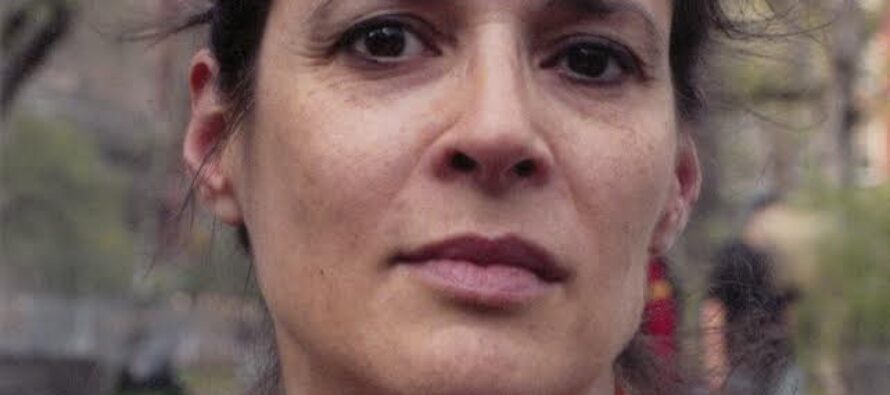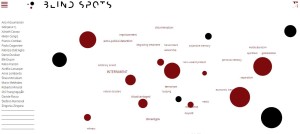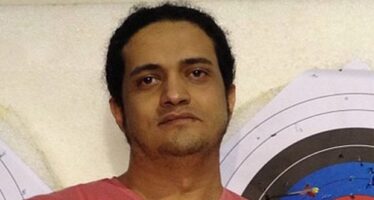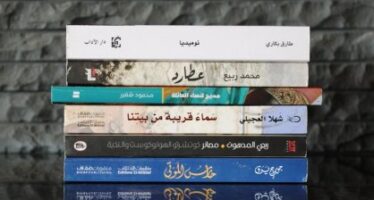BLIND SPOTS: A platform of reflection interweaving law and poetry

![]()
Debra Werblud (www.debrawerblud.com) is a multimedia, interdisciplinary visual artist. She made Venice her home years ago and from her Giudecca studio she makes ‘incursions’ into difficult themes in difficult times (politically, artistically, culturally, economically), always leaving a permanent mark on her audience and, more generally, on those coming into contact with her (professionally and personally). She is a sophisticated artist, and sophistication here should not imply difficulty in understanding her work. On the contrary, her work is strikingly clear, and it is this “transparency” that makes her so sophisticated and direct. Her work is deeply interwoven with reality, both social and political. Rather than a statement, it’s a permanent questioning. Rather than an object, it’s an ongoing process. Her work impartsa public social role for art through dialectical process. She induces her audience to claim ownership then question their own consistency…
From the presentation of her latest project for an installation entitled “Dropping Seeds” (a reflection on genocide and its recurrence, on the interconnectedness of historic and current events; on the legacies of atrocities seeded in our lives that stoke acts of inhumanity):
“Werblud’s body of work ranges from installation art to concept development for institutions and industries. The themes reflect persistent social and moral issues, an urge to draw attention to overlooked continuities and potential alliances, draw to the surface that which has been erased or lies in wait.
Werblud’s installations stage a transitional state that aims to elicit from its visitors recognition of and identification with another moral reality. Imagery is drawn; phenomena are drawn from nature. Representation shifts into abstraction. Each composition is a modular system of unique and variable components; their assemblage is a poetic conceit for fusing the sensory with the abstract. The media and production processes, the incorporation of a site’s features emphasize the interplay between perspective, scale, physicality, context.
Early studies in sculpture, archaeology, anthropology and environmental design as well as experience in participatory design also underpin Werblud’s collaborative work with artisans, scientists, scholars, poets, planners and architects. Each project is conceived as a vehicle for accessing the unfamiliar, for triggering then nurturing processes of interdependence.
How did the blindspots.eu project come about? Who thought of it, what were their concerns?
The client is a foundation, see Fondazione Venezia per la Ricerca sulla Pace http://www.veripa.org. A description of the project can be found in BLIND SPOTS’ menu under ABOUT http://blindspots.euor by clicking the name in the header.
I quote from the first paragraph:
“BLIND SPOTS is a pilot project of the Fondazione Venezia per la Ricerca sulla Pace as part of their ongoing research in the role of memory in processes of peace building and European integration. As scholars of international law, members of the foundation sought media that might draw a non-specialist public to the ever-relevant subjects of their studies.
Intent on introducing alternative instruments of communication as vehicles for social change, the Foundation pursued a partnership withPhonodia, the UniversitàCa’ Foscari Venezia’s online poetry audio archive.”
In 2014, the Foundation’s board of directors included an exceptional individual, Elide Pittarello, a scholar of Spanish literature teaching at Ca’ Foscari who had founded with one of her students, Alessandro Mistrorigo, Phonodia: http://phonodia.unive.it/, an online archive of the recordings of living poets. She knew of my past work; it was she who recommended they meet me. She had managed to rouse their curiosity in art as an instrument.
In consulting work, my approach is to latch on to what’s already there, identify commonalities, provide strategic links … all with the goal of inspiring at least inquiry. The connection between poets with scholars of human rights law and peace studies was pretty straightforward. Again, from the introduction:
“The quote from Coleridge, ‘poetry; the best words in the best order,’ might equally apply to the creative skills necessary to formulating laws, including the coining of words to describe the indescribable. In some departments of jurisprudence, poetry is taught for its tools of analysis of complexities and ambiguities. Yet the same tools that relieve poetry of imposing a rational
system of judgment and decision and puts poetry at ease with uncertainty stand in contrast to the specificity sought in law.
BLIND SPOTS, in its interweaving of law and poetry, is about processes of becoming, as a project, as a spur to interpretation, as a challenge to the framing that determines individuals’ perceptions, attitudes, behavior. The project is launched as a platform for reflection; as it evolves, it aspires to
stimulating critical engagement and inquiry.”
How important is it for artists – if it is – to be involved in what is happening around them … in other words, the eternal question: should artists be involved and therefore include in their production their own idea, image, view of contemporary politics…
Whether an individual is an artist, a doctor, a farmer, there are choices that will be made as political beings. A doctor might have license to refuse to perform abortions, a farmer might use genetically modified seeds and pesticides, and so forth. Our choices – as human beings, as citizens, as professionals – have repercussions. The doctor’s choice to not perform abortions will reflect certain religious and/or social indoctrination; that of the farmer will reflect what he believes will secure him financial returns. Undoubtedly, there will be narratives to back the choices made. The artist is no different. While working on a project to promote sustainable fishing practices, I heard of fishermen who destroy the sea floor in search of clams, claiming that their activity is good for sea floor habitats and new growth because it is akin to a farmer aerating his fields. This is insane. The difference for artists is that the nature of their work leads to public exposure. They can use their work to expose injustice by sounding sirens, rousing imaginations, challenging sources, criteria, norms … How they go about doing so is the most personal part of the process.
A few months ago, I was at a conference in which a visual artist and a journalist/poet presented and discussed their work concerned with violations of human rights. A student in the audience questioned whether their work was activism. After hearing some discussion, I intervened by stating that there are many forms of activism, denouncement needs the most effective expression an individual is capable of – whether it is out in the streets, scaling a ship, or on a sheet of paper. Publicly voicing issues, even putting one’s life on the line, can and must assume many forms if it is to bore through filters of denial and disinformation. We could also look at how much art and artists have influenced methods of protest over the years… The fact is that we all tend to commit to a cause when we feel threatened, when we can recognize ourselves in that cause. The challenge for the more politically active artist is how to draw forth those aspects of an issue in which those who do not recognize themselves as invested, at risk, might identify; how to spur on those mirror neurons.
The skilled artist, like any skilled individual practicing their vocation, can adopt a privileged position should they opt to use it. They can move through any and all sectors of all societies, be aberrations and chameleons – whatever it takes to constantly shift their point of view. It’s a matter of deliberate choice, risk and discipline. In answer to your question – it’s not whether artists “should be involved” – they are involved; they will, despite themselves, “include in their production their own idea, image, view of contemporary politics” … not to say, it won’t be insipid. It’s whether and how any of us have equipped ourselves to risk stability, live with rejection, derision, failure; shift priorities, reckon with beauty and grotesque brutality in the same breath… No different from the concerns of a certain kind of journalism, for example. If we are aware of the urgency of an injustice, then we may feel we have an obligation to act on it.
When working towards developing an interdisciplinary practice, artists and their art generally bear the stigma of being “extra” or non-essential, turned to like someone’s last ditch call to some greater deity; the potential is rarely given the opportunity to enjoy full expression unless initiated by the artists themselves. And when there is an opportunity, the client – an institution, for ex. – may be curious, may even be enamored of an idea, but there is a significant learning curve before they recognize the depths of impact an artist’s intervention can have and are prepared to adequately finance a project, commit to nurturing the project beyond its concept phase.
This project was fortunate to have at the outset an informed and committed champion prepared to challenge convention and open-minded, receptive members of the Foundation.
In this sort of project, the artist is not at the center but is a catalyst; in turn, the project is conceived as a catalyst.
How did you become involved in BLIND SPOTS on a more personal level?Did you, for example, need to share concerns and thoughts with the poets involved?
Blind Spots was an opportunity to do something that I’d been thinking about for a while, discussing with a few friends: how to devise instruments, means for drawing together overlooked connections that provoke further consideration … how to facilitate access to diverse sources of information, from there introduce other criteria in order to practice vigilance and make informed choices.
I notice that in your introduction, as part of my biography, you refer to a project that I’ve been working on for a couple of years – “Dropping Seeds”. The potential for mapping, radical cartographies, actually arose there, out of a discussion with Roger Connah, professor at the Azrieli School of Architecture and Urbanism at Carleton University, in considering the interconnectedness of genocides. Roger has been working on diagrams that he calls calligraphisms for years, graphically wonderful analytical tools. Associated with the installation, we are aiming for the opportunity to develop a web-based interactive multimedia resource that will connect genocides of the 20th Century.
BLIND SPOTS was a first opportunity to research methods for handling similarly complex data in a web-based project. I had not worked with written language beyond its illustration; I had not worked with poetry, let alone human rights law. How to open the language of human rights’ law to a diverse public? How to listen to, let alone hear a voice in a language you don’t necessarily understand? How to contextualize the words, the terms, so they have meaning?
Given that this was a pilot project with a tight budget, there were a number of important limitations – such as necessarily using poets already recorded by Phonodia. Thepoets’ personal biographies made them appropriate, but the selection of recorded poems available were not necessarily their most relevant. At this early phase, the point was to design the site’s architecture so that it could suggest and eventually incorporate new attributes, indicate what would be needed to organize and sustain an ever-evolving project.
Language is a huge factor. This is a European project for an Italian research foundation. What language to use as the site’s lingua franca; how could we make a language accessible to those who may not know that language so that they would listen to poetry that they would otherwise ignore? This was a concern necessarily discussed with some of the poets, was even cause for poets’ reticence to participate. A few of the Phonodia poets solicited did not because of a language barrier, others because of concerns about the audience, others were discouraged by the questionnaire. In the future, the selection of poets and poetry will necessarily be specific to a BLIND SPOTS’ project. The Foundation agrees that we might pursue certain themes,select the voices of poets associated with, for example, climate change and migration, children born of war rape, poetry as coded communication …
This project would not have been possible without Phonodia and its director Alessandro Mistrorigo who bent over backwards to select and solicit the initial interest then trust of the poets. I was fortunate in that one of the poets actually lives in Venice, Anna Lombardo. With her, I was able to perfect the questionnaire. Through her, I was introduced to the Associazione di Amicizia Italia-Cuba of Venice and to the poets participating in their festival of poetry last spring: La palabra en el mundo. Another of our poets, Ana Azourmanian, an Argentine poet and lawyer, genocide scholar, and child of the Armenian diaspora has also been a significant resource –her commitment, as amiable as it has been professional … Of the 19 participating poets of this pilot project, almost all have conferred some quality to the project that could not possibly have been planned. On a personal level, a number of precious new friendships have resulted; on a professional one, analytical and technical methods learned will undoubtedly underpin new projects.
So many rewarding aspects: the gratification of discovery as I delved first into the history of human rights law, then the poetry in an effort to provide contextualization that might inspire the site’s visitors to access the poet in another light, begin to draw comparisons and connections; the creative experience in working with our web developer James Nylen; the exceptional commitment from my assistant, the web designer Luca De Luigi, who interpreted the language of code so that a dinosaur such as me could bring the concept to fruition; the Foundation’s curiosity and commitment, and recognition of the value of their investment.
A significant next step will be to link the Foundation’s research once it has been uploaded to their website. We are also counting on receiving more translations from the poets already posted. From there, the client will decide how to proceed… The project is elastic.
How did you actually create the page? And how does it work? Did you make it collectively? Do people post their own poems, thoughts etc.? Or are these posted by an “editor”?
The first step was developing the concept with regular feedback from the client’s advisory team. From the outset, the goal of BLIND SPOTS was to create a platform for listening to voices and alerting the visitor to terms broached in human rights law – how they are used in our everyday lives – that when put to the test can determine the choices we make, our behavior to that which falls outside our comfort zone.
Study of the Foundation’s literature, the principal sources of their research served in selecting the themes. When reading about the creation of international human rights law, I began to look into conditions that signal risk, the difference between crimes against humanity and genocide…The sources can be found in the site’s MENU. A list of terms was drawn up then perfected with the guidance of one of the project’s advisors, Simona Pinton. By no means exhaustive, we were limited to a certain number that the code could manage.
My assistant, the web designer Luca De Luigi, did some online research and found a creative commons project by a web developer in the US, James Nylen. His project had many of the mapping characteristics sought. Had we attempted to create a program entirely ex novo, the costs would have skyrocketed. We contacted him, asked if he would be willing to adapt his code to meet our needs. From here, a storyboard was sketched, reviewed and authorized by the client. Over the course of the site’s making, the rigor of code development both improved and thwarted functional sequences laid out in the initial storyboard. Development has something of building a medieval cathedral to it, with James the master-builder.
From the outset, it was critical to predispose the design for layering that could incorporate future growth as well as improvements to the pilot project. The first of these will be links to the Foundation’s research through the menu’s glossary once their publications are rendered into digital documents.
And is it possible for poets to contribute freely?
Given the complexity of the project’s code and the thematic approach, this is simply not practical. Participating poets are encouraged to provide additional input and translations as they become available. Once the links to the Foundation’s research are integrated this year, the Foundation will evaluate how they wish to proceed.
BLIND SPOTS was and will continue to be a collaborative effort: from discussions with the Foundation’s advisory Foundation’s advisory team in the development of the concept, to the selection of poets by Phonodia, to the technical and functional limitations introduced by the web designers, to the contributors’ input.
BLIND SPOTS was created to be a catalyst.
Credit photo © Max Kozloff
Related Articles
‘Experimental Works’ Chosen for 2016 International Prize for Arabic Fiction Shortlist
![]()
The region’s recent historical tragedies are certainly explored here, from the Palestinian nakba
Kobane, three years after
![]()
Patrizia Fiocchetti was in Kobane just after its liberation from DAESH, in January 2015





